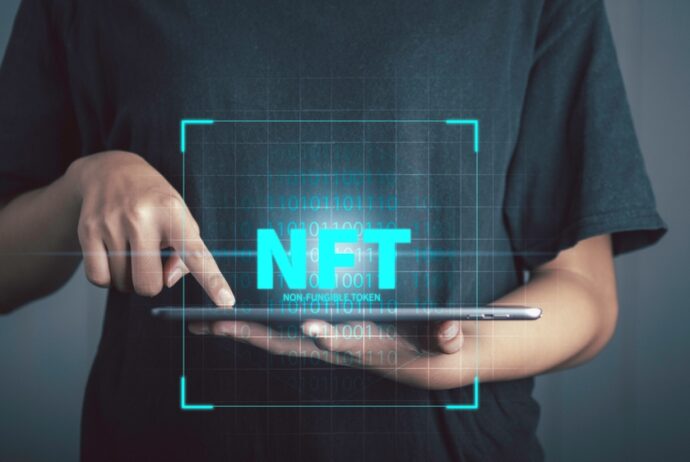The world of digital ownership is evolving, and Non-Fungible Tokens (NFTs) are at the forefront of this revolution. Non-fungible tokens (NFTs) have recently gained tremendous popularity, with artists earning millions of dollars from selling a single NFT.
Within a year, the NFT market has experienced an exponential increase, and analysts predict that by 2025, the industry will be valued at an astonishing $80 billion, according to Jefferies, an investment bank. In this guide, we will explore NFTs, how they work, and how to get started with them.
What is an NFT?

CypherMindHQ.com Artificial Intelligence Crypto Trading System - Surpass the competition with this cutting-edge AI system! Utilize the prowess of innovative algorithms and amplify your crypto trading strategies with CypherMindHQ. Learn more today!
An NFT is a unique digital asset that uses blockchain technology to verify its authenticity, ownership, and scarcity. Unlike cryptocurrencies, which are fungible, meaning that each unit is interchangeable and of equal value, NFTs are one-of-a-kind and can represent any type of digital asset, including artwork, music, videos, and more.
This uniqueness makes them valuable for creators and collectors alike, particularly in the worlds of digital art, gaming, and collectibles. Further, each NFT is unique and has a specific identifier stored on a blockchain, which serves as proof of ownership and authenticity.
This implies that ownership of an NFT is unchangeable and exclusive, making them highly desirable. As a result of their rarity, creators and owners of NFTs can establish their pricing for these digital assets.
How do NFTs work?
NFTs use blockchain technology to create a digital certificate of ownership for a specific asset. This unique certificate cannot be duplicated, making the asset one-of-a-kind. When an NFT is created, it is assigned a particular set of metadata, including information about the asset and its ownership history. This information is then recorded on a blockchain, which acts as a permanent and transparent ledger.
When an NFT is purchased or sold on online marketplaces using cryptocurrency as payment, the transaction is recorded on the blockchain, and ownership is transferred to the buyer. Moreover, the buyer can again sell or trade the NFT as they see fit, and the ownership will be transferred to the new owner.
One of the critical features of NFTs is their scarcity. Each NFT is unique, and a limited number of them are available. This scarcity gives NFTs their value, as they are seen as collectibles.
How to get started with NFTs

CypherMindHQ.com Artificial Intelligence Crypto Trading System - Outpace the competition with this high-end AI system! Leverage the capabilities of progressive algorithms and enhance your crypto trading performance with CypherMindHQ. Learn more today!
Getting started with NFTs may seem daunting, but it is a straightforward process that requires a basic understanding of blockchain technology and cryptocurrency. Here are the steps you can take to get started:
- Create a cryptocurrency wallet
To buy and sell NFTs, it’s essential to have a cryptocurrency wallet that offers secure storage for your NFTs and cryptocurrency. There are numerous cryptocurrency wallets to choose from, such as MetaMask, Coinbase Wallet, and Trust Wallet.
- Purchase Cryptocurrency
Buying NFTs involves purchasing cryptocurrency, with Ethereum being the most commonly used cryptocurrency for NFT transactions. However, some NFT marketplaces may accept other cryptocurrencies as well.
- Choose an NFT marketplace
NFTs may be purchased and sold on various platforms, including OpenSea, Nifty Gateway, and SuperRare, each with its benefits and drawbacks. Thus, conducting proper research before selecting a marketplace is crucial to ensure it aligns with your NFT trading requirements.
- Browse and purchase NFTs
After selecting an NFT marketplace, you can peruse the available NFTs and use your cryptocurrency wallet to purchase them. Each NFT has a distinct identification code stored on a blockchain, which functions as evidence of ownership and verifies its authenticity.
Tips for buying and selling NFTs
When buying and selling NFTs, it’s essential to keep the following tips in mind.
- Do your research – Before buying an NFT, research the artist and the marketplace. Look at the artist’s previous work and their reputation in the industry. Also, examine the marketplace’s fees and policies to ensure you get a fair deal.
- Verify the authenticity of the NFT – Before buying an NFT, ensure that it is authentic and has not been tampered with. Verify its unique identifier code on the blockchain to confirm ownership and authenticity.
- Set a budget – Determine how much you’re willing to spend on an NFT and stick to it. It’s easy to get caught up in the hype and overspend, so having a budget in place can help you make informed decisions.
- Sell at the right time – If you’re selling an NFT, consider the current market conditions and sell at a time when demand is high. Keep an eye on market trends and adjust your selling price accordingly.
- Keep your NFTs secure – Ensure that your NFTs are stored securely in a reputable cryptocurrency wallet to prevent theft or loss. Regularly back up your wallet to protect your assets in case of any unforeseen circumstances.
Conclusion
In conclusion, NFTs are revolutionizing the world of digital ownership and are expected to impact the future significantly. In addition, the NFT market is proliferating, and as more people embrace this innovative technology, the possibilities for the future of digital ownership are endless.



